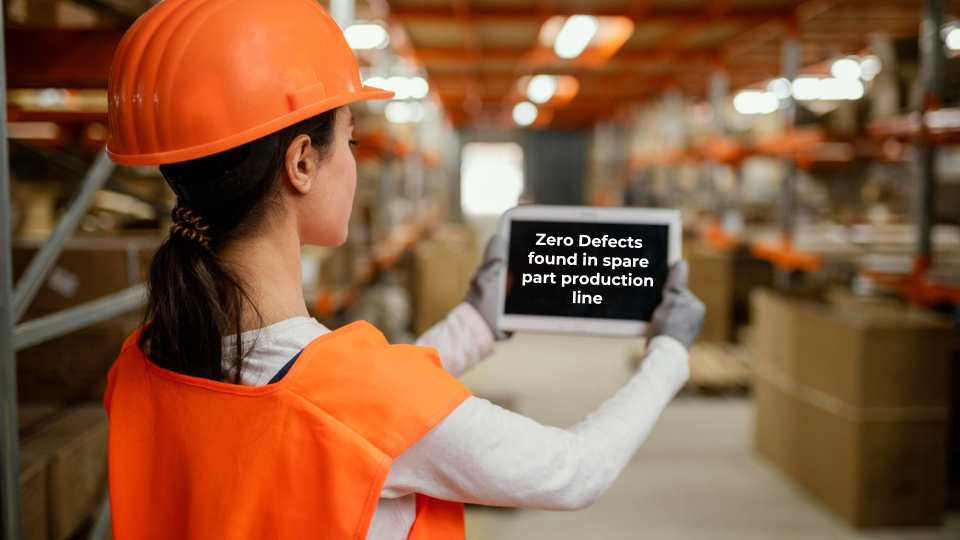Kaizen in Quality Control: The Zero Defect Zone – A Mindset Shift for Continuous Improvement
March 13, 2025
In today’s hyper-competitive manufacturing landscape, achieving zero defects is not just a quality initiative—it’s a business survival strategy. Defects aren’t just about rework; they represent hidden costs, lost customers, and damaged reputations.
Companies like Toyota, GE, and aerospace manufacturers don’t merely reduce defects; they strive to eliminate them entirely. This shift from reactive quality control to proactive defect prevention is the essence of modern Kaizen. Businesses that embrace this philosophy see increased profitability, streamlined operations, and greater customer trust.
The question is no longer, ‘Can we reduce defects?’ but ‘Why are we allowing them at all?’
The Zero Defect Mindset: Why It’s a Leadership-Driven Transformation?
Traditional quality control relies on catching and fixing errors. But fixing is failure—the real goal should be preventing defects from happening in the first place. This requires a mindset shift, one that starts at the executive level.
Incremental Kaizen Isn’t Enough
Most organizations adopt continuous improvement (Kaizen) in small, incremental steps. But zero defects require a quantum leap, not just a slow climb. Leaders must challenge the status quo and demand perfection, not just improvement.
From Cost-of-Defects to Value-of-Quality
Historically, manufacturers accept a certain percentage of defects, assuming that perfection is too expensive. In reality, the cost of defects—recalls, warranty claims, customer dissatisfaction—far outweighs the investment in defect prevention.
The ‘Acceptable Defect’ Myth
Many organizations operate under the belief that "some defects are inevitable." This thinking cripples competitiveness. In high-stakes industries like aerospace, semiconductors, and medical devices, even a 0.001% defect rate can be catastrophic. Zero defects is not just an ideal—it’s a necessity.

Executives must redefine success, shifting the goal from meeting quality targets to ensuring that defects never occur at all. This mindset transformation is the foundation of a true Zero Defect Zone.
Building the Zero Defect Zone: Key Operational Shifts
1. Proactive Quality Assurance vs. Reactive Quality Control
Traditional quality control identifies defects after production—but by then, it’s too late. Instead, proactive quality assurance ensures that processes are designed to prevent defects from occurring in the first place. Root cause elimination replaces symptom treatment. Smart manufacturers embed quality into every stage, leveraging predictive maintenance, real-time monitoring, and Six Sigma methodologies to ensure first-pass success.
2. Poka-Yoke: Error-Proofing as a System, Not a Tool
Poka-Yoke (mistake-proofing) is more than just a few clever fixtures on the shop floor—it’s a systematic approach to eliminating human and process errors. Companies use AI-driven sensors, IoT-enabled alerts, and automation to detect micro-defects before they become major failures. When machines and processes make errors impossible, human intervention becomes a last resort.
3. Real-Time Process Control & Digital Twin Technology
Predictive analytics is revolutionizing quality control. Instead of reacting to defects, AI-driven models predict and prevent them. Digital twins—virtual replicas of manufacturing processes—allow executives to simulate and refine production before real-world execution. By testing scenarios in a digital environment, businesses can eliminate defects before they even exist.
4. First-Time-Right Production Mindset
The best way to reduce rework, scrap, and customer complaints is to get it right the first time. A zero-defect approach emphasizes designing processes that prevent errors rather than fixing them. This mindset shift reduces lead times, improves profit margins, and enhances customer trust—because nothing builds a brand faster than flawless execution.
Culture Transformation: Aligning Teams with Zero Defect Thinking
A zero-defect culture doesn’t happen by accident—it requires a fundamental shift in how people think, work, and communicate. The best strategies fail if the workforce doesn’t buy into the mission.
From Blame to Learning: Creating Psychological Safety for Defect Prevention
In many companies, employees fear reporting defects due to punishment or blame. This leads to hidden quality issues. Instead, creating a culture of learning, where errors are treated as opportunities for improvement, encourages early defect detection and resolution.
Training and Upskilling: Redefining Workforce Competency for a Defect-Free Future
Quality doesn’t come from procedures alone—it comes from people. Investing in lean thinking, Six Sigma training, and advanced problem-solving methodologies equips teams to identify and eliminate defects at the source.
Gamification and Continuous Feedback Loops for Sustained Engagement
Zero defects must be exciting, not exhausting. Leading companies use real-time feedback systems, visual management boards, and incentive programs to keep employees engaged in quality initiatives. Make defect elimination a game, not a chore.
Metrics & Accountability: Measuring Zero Defect Performance
What gets measured gets managed. Achieving zero defects isn’t just about tracking failures—it’s about measuring process health and predictive quality indicators.
Beyond Defect Rates: Advanced KPIs for Zero-Defect Manufacturing
- First-pass yield (FPY) – The percentage of products made perfectly the first time.
- Process capability index (Cpk, Ppk) – Measures how well a process produces within specifications.
- Cost of Poor Quality (COPQ) – A financial metric revealing how much defects are costing the business.
How Real-Time Dashboards & AI-Driven Analytics Create a Culture of Defect Prevention
- AI-powered quality control systems detect early-stage process deviations, preventing major failures.
- Digital dashboards provide instant visibility into quality trends and root causes.
- Executive-level insights align leadership decisions with defect prevention strategies.
Leading vs. Lagging Indicators: Why Traditional Metrics Are Not Enough
- Leading indicators (process variation, equipment stability) predict defects before they occur.
- Lagging indicators (defect rates, warranty claims) only tell you what already went wrong.
- A true Zero Defect Zone focuses on prevention, not post-mortems.
Conclusion
As Industry 4.0 accelerates, zero defects is no longer an aspiration—it’s an expectation. Companies that embrace proactive quality control, real-time analytics, and a culture of defect prevention will outcompete those still relying on outdated, reactive methods. The benefits are undeniable: lower costs, increased efficiency, higher customer trust, and a future-proof manufacturing process.

At Orca Lean, we understand that achieving zero defects requires more than just mindset shifts—it demands the right tools and technology. That’s why we built SolvoNext, a cutting-edge digital solution designed to help manufacturers identify, prevent, and eliminate defects before they happen.
- Predict and prevent defects in real-time with AI-powered analytics
- Enhance process visibility and control with intuitive dashboards
- Empower teams with real-time feedback loops for sustained quality improvements
The time to act is now. Don’t wait for defects to drain your profits or damage your reputation.

Software Solutions for Manufacturing Excellence
Company
Social
Our Contact Info:
Email: contact@orcalean.com
Phone Number: 248 938 0375
Our Offices
